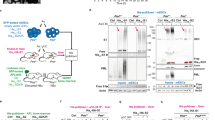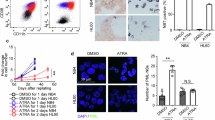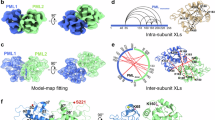Abstract
Promyelocytic leukemia nuclear bodies (PML-NBs) comprise multiple regulatory factors and play crucial roles in the maintenance of cellular integrity, while unregulated activation of PML-NBs induces death and premature senescence. Hence, the function of PML-NBs must be directed properly; however, the mechanism that regulates PML-NBs remains unclear. In this paper, we show that PML-NBs are disintegrated by an AT-rich interaction domain family protein E2FBP1/hDril1 through specific desumoylation of promyelocytic leukemia protein (PML) in vivo and in vitro. RNA interference-mediated downregulation of E2FBP1/hDril1 results in hyperplasis of PML-NBs and consequent commitment to PML-dependent premature senescence. Thus, the function of E2FBP1/hDril1 is required for maintenance of survival potential of the cells. Our data suggest a novel mechanism to govern cellular integrity through the modulation of nuclear depots.
Similar content being viewed by others
Log in or create a free account to read this content
Gain free access to this article, as well as selected content from this journal and more on nature.com
or
Abbreviations
- IgH:
-
immunoglobulin heavy chain
- ND10:
-
nuclear domain 10
- pRb:
-
retinoblastoma susceptible gene product
- IP:
-
immune complex
- DOC:
-
deoxycholic acid sodium salt
- ORF:
-
open reading frame
- RNAi:
-
RNA interference
- PAI-1:
-
plasminogen activator inhibitor-1
- SA-β-gal:
-
senescence-associated β-galactosidase
References
Suzuki M, Okuyama S, Okamoto S, Shirasuna K, Nakajima T, Hachiya T, Nojima H, Sekiya S and Oda K (1998) A novel E2F binding protein with Myc-type HLH motif stimulates E2F-dependent transcription by forming a heterodimer. Oncogene 17: 853–865
Kortschak RD, Reimann H, Zimmer M, Eyre HJ, Saint R and Jenne DE (1998) The human dead ringer/bright homolog, DRIL1: cDNA cloning, gene structure, and mapping to D19S886, a marker on 19p13.3 that is strictly linked to the Peutz–Jeghers syndrome. Genomics 51: 288–292
Kortschak RD, Tucker PW and Saint R (2000) ARID proteins come in from the desert. Trends Biochem. Sci. 25: 294–299
Gong L, Kamitani T, Fujise K, Caskey LS and Yeh ET (1997) Preferential interaction of sentrin with a ubiquitin-conjugating enzyme, Ubc9. J. Biol. Chem. 272: 28198–28201
Zong RT, Das C and Tucker PW (2000) Regulation of matrix attachment region-dependent, lymphocyte-restricted transcription through differential localization within promyelocytic leukemia nuclear bodies. EMBO J. 19: 4123–4133
Webb CF (2001) The transcription factor, Bright, and immunoglobulin heavy chain expression. Immunol. Res. 24: 149–161
Herrscher RF, Kaplan MH, Lelsz DL, Das C, Scheuermann R and Tucker PW (1995) The immunoglobulin heavy-chain matrix-associating regions are bound by Bright: a B cell-specific trans-activator that describes a new DNA-binding protein family. Genes Dev. 9: 3067–3082
Borden KL (2002) Pondering the promyelocytic leukemia protein (PML) puzzle: possible functions for PML nuclear bodies. Mol. Cell Biol. 22: 5259–5269
Maul GG, Negorev D, Bell P and Ishov AM (2000) Review: properties and assembly mechanisms of ND10, PML bodies, or PODs. J. Struct. Biol. 129: 278–287
Negorev D and Maul GG (2001) Cellular proteins localized at and interacting within ND10/PML nuclear bodies/PODs suggest functions of a nuclear depot. Oncogene 20: 7234–7242
Seeler JS and Dejean A (1999) The PML nuclear bodies: actors or extras? Curr. Opin. Genet. Dev. 9: 362–367
Eskiw CH and Bazett-Jones DP (2002) The promyelocytic leukemia nuclear body: sites of activity? Biochem. Cell Biol. 80: 301–310
Pearson M and Pelicci PG (2001) PML interaction with p53 and its role in apoptosis and replicative senescence. Oncogene 20: 7250–7256
Salomoni P and Pandolfi PP (2002) The role of PML in tumor suppression. Cell 108: 165–170
Everett RD (2001) DNA viruses and viral proteins that interact with PML nuclear bodies. Oncogene 20: 7266–7273
Benoit G, Roussel M, Pendino F, Segal-Bendirdjian E and Lanotte M (2001) Orchestration of multiple arrays of signal cross-talk and combinatorial interactions for maturation and cell death: another vision of t(15;17) preleukemic blast and APL-cell maturation. Oncogene 20: 7161–7177
Pearson M, Carbone R, Sebastiani C, Cioce M, Fagioli M, Saito S, Higashimoto Y, Appella E, Minucci S, Pandolfi PP and Pelicci PG (2000) PML regulates p53 acetylation and premature senescence induced by oncogenic Ras. Nature 406: 207–210
Ferbeyre G, de Stanchina E, Querido E, Baptiste N, Prives C and Lowe SW (2000) PML is induced by oncogenic ras and promotes premature senescence. Genes Dev. 14: 2015–2027
James P, Halladay J and Craig EA (1996) Genomic libraries and a host strain designed for highly efficient two-hybrid selection in yeast. Genetics 144: 1425–1436
Fogal V, Gostissa M, Sandy P, Zacchi P, Sternsdorf T, Jensen K, Pandolfi PP, Will H, Schneider C and Del Sal G (2000) Regulation of p53 activity in nuclear bodies by a specific PML isoform. EMBO J. 19: 6185–6195
Everett RD, Lomonte P, Sternsdorf T, van Driel R and Orr A (1999) Cell cycle regulation of PML modification and ND10 composition. J. Cell Sci. 112 (Part 24): 4581–4588
Zhong S, Müller S, Ronchetti S, Freemont PS, Dejean A and Pandolfi PP (2000) Role of SUMO-1-modified PML in nuclear body formation. Blood 95: 2748–2752
Ishov AM, Sotnikov AG, Negorev D, Vladimirova OV, Neff N, Kamitani T, Yeh ET, Strauss 3rd JF and Maul GG (1999) PML is critical for ND10 formation and recruits the PML-interacting protein daxx to this nuclear structure when modified by SUMO-1. J. Cell Biol. 147: 221–234
Best JL, Ganiatsas S, Agarwal S, Changou A, Salomoni P, Shirihai O, Meluh PB, Pandolfi PP and Zon LI (2002) SUMO-1 protease-1 regulates gene transcription through PML. Mol. Cell 10: 843–855
Gostissa M, Hengstermann A, Fogal V, Sandy P, Schwarz SE, Scheffner M and Del Sal G (1999) Activation of p53 by conjugation to the ubiquitin-like protein SUMO-1. EMBO J. 18: 6462–6471
Rodriguez MS, Desterro JM, Lain S, Midgley CA, Lane DP and Hay RT (1999) SUMO-1 modification activates the transcriptional response of p53. EMBO J. 18: 6455–6461
Li S-J and Hochstrasser M (1999) A new protease required for cell-cycle progression in yeast. Nature 398: 246–251
Hannon GJ (2002) RNA interference. Nature 418: 244–251
Ohtani N, Zebedee Z, Huot TJ, Stinson JA, Sugimoto M, Ohashi Y, Sharrocks AD, Peters G and Hara E (2001) Opposing effects of Ets and Id proteins on p16INK4a expression during cellular senescence. Nature 409: 1067–1070
Serrano M, Lin AW, McCurrach ME, Beach D and Lowe SW (1997) Oncogenic ras provokes premature cell senescence associated with accumulation of p53 and p16INK4a. Cell 88: 593–602
Dimri GP, Lee X, Basile G, Acosta M, Scott G, Roskelley C, Medrano EE, Linskens M, Rubelji I, Pereira-Smith O, Peacocke M and Campisi J (1995) A biomarker that identifies senescent human cells in culture and in aging skin in vivo. Proc. Natl. Acad. Sci. USA 92: 9363–9367
Xu ZX, Timanova-Atanasova A, Zhao RX and Chang KS (2003) PML colocalizes with and stabilizes the DNA damage response protein TopBP1. Mol. Cell Biol. 23: 4247–4256
Harlow E and Lane D (1999) Immunoaffinity purification. In Using Antibodies; A Laboratory Manual, 1st edn. (New York: Cold Spring Harbor Laboratory) pp. 311–343
Kaplan MH, Zong RT, Herrscher RF, Scheuermann RH and Tucker PW (2001) Transcriptional activation by a matrix associating region-binding protein. Contextual requirements for the function of bright. J. Biol. Chem. 276: 21325–21330
Peeper DS, Shvarts A, Brummelkamp T, Douma S, Koh EY, Daley GQ and Bernards R (2002) A functional screen identifies hDRIL1 as an oncogene that rescues RAS-induced senescence. Nat. Cell Biol. 4: 148–153
Smith P, Krohn R, Hermanson G, Mallia A, Gartner F, Provenzano M, Fujimoto E, Goeke N, Olson B and Klenk D (1985) Measurement of protein using bicinchoninic acid. Anal. Biochem. 150: 76–85
Acknowledgements
We thank Y Takahashi and Y Kikuchi for discussions, the HA-tag DNA fragment and the expression plasmid for GST-Ulp1. This work was partly supported by a Grant-in Aid for Scientific Research from the Japan Society for the Promotion of Science.
Author information
Authors and Affiliations
Corresponding author
Additional information
Edited by H Ichijo
Rights and permissions
About this article
Cite this article
Fukuyo, Y., Mogi, K., Tsunematsu, Y. et al. E2FBP1/hDril1 modulates cell growth through downregulation of promyelocytic leukemia bodies. Cell Death Differ 11, 747–759 (2004). https://doi.org/10.1038/sj.cdd.4401412
Received:
Revised:
Accepted:
Published:
Issue date:
DOI: https://doi.org/10.1038/sj.cdd.4401412
Keywords
This article is cited by
-
ARID3a from the ARID family: structure, role in autoimmune diseases and drug discovery
Acta Pharmacologica Sinica (2023)
-
The potential link between PML NBs and ICP0 in regulating lytic and latent infection of HSV-1
Protein & Cell (2012)



